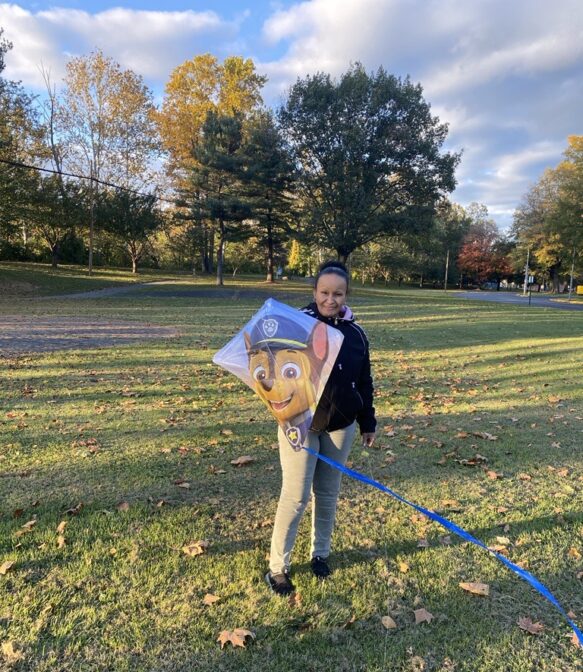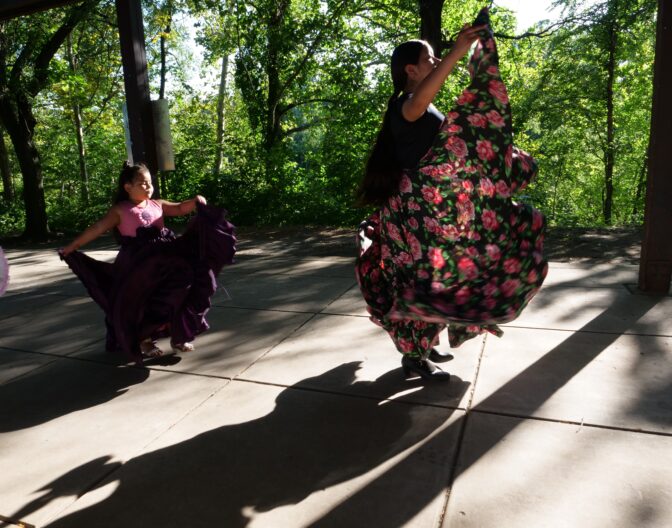
Yuritzkiri Sixto Medina is the founder and lead instructor of Grupo Uarhani in Reading.
Gabriela Martinez / WITF

Yuritzkiri Sixto Medina is the founder and lead instructor of Grupo Uarhani in Reading.
Gabriela Martinez / WITF

Gabriela Martinez / WITF
Yuritzkiri Sixto Medina is the founder and lead instructor of Grupo Uarhani in Reading.
During warm months, Gloria García likes to fly kites at Reading’s Riverfront Park. It is a hobby that dates back to her childhood days in Puerto Rico. Her uncle used to make paper kites.
“It’s something I’ve never stopped doing. I always try to take advantage of windy days like this,” García said. “It makes me feel like I’m in Puerto Rico.”
García has lived in Reading for 22 years. Riverfront Park has always been a place for her to relax and get some exercise. In the summer, she would bring her grill and host picnics.

Gabriela Martinez / WITF
Gloria García likes to go to Riverfront Park to fly kites.
But the park has changed. Riverfront Drive, the street next to the park, is now a “No Parking” zone, which makes it harder to bring a grill and other picnic supplies.
García still stops by the park to walk her dog. Usually, her husband will park on Riverfront Drive, wait by the car and keep a lookout for police or tow trucks.
“I have to be alert. Sometimes the police officer will see I’m just walking my dog and not say anything, but sometimes there are more people and the police will stop and ask everyone to leave,” García said.
Riverfront Park is a roughly 7-acre walking path along the Schuylkill River. It’s a popular gathering spot and swimming destination in the summer, but complaints of noise and littering prompted the city to ban parking along the park.
Plans to develop the riverfront have been on the table for a long time, but none has come to fruition. In the meantime, some nonprofits are working to promote a healthier use of the riverfront area and highlight its potential.
Some urbanism experts consider riverfronts valuable economic and cultural assets. With the proper development practices, riverfront areas can generally lead to healthier cities. A number of cities across the country, such as Fort Wayne in Indiana, as well as some in Pennsylvania – Pittsburgh, for example – have found economic success in waterfront projects.
Loud partying, motorcycle drag racing and littering at Riverfront Park gained attention around 2020. With many indoor recreational spots shut down because of the pandemic, the park became a go-to outside gathering spot.
There was “overwhelming noise,“ discarded cases of beer and other trash strewn all over the park, said City Council President Donna Reed. There were also concerns about unsafe swimming conditions, and potential contamination in the water. So the city made those “No Parking” areas to try to alleviate the overcrowding and the conditions that created public safety issues, Reed said.
“It’s a shame for the people who really want to use it for the right reason, because they should be able to step into the river and cool their feet down and have their children enjoy a natural environment, but there’s always bad actors and bad actors really made the problem, not just a problem for the city, but a problem for our neighbors across the riverbank in West Reading,” Reed said.
At a June 2022 meeting, Ryan Lineaweaver, West Reading Borough Council President, told city council members loud parties were affecting the quality of life of some residents.
Reading police records show there were 17 calls related to noise complaints between January 1st and July 31, 2022. That summer, the Reading Eagle reported, the Reading Police Department and the public works department were working together to install “No Parking” signs along Riverfront Drive. Reading police records show no noise calls for the rest of 2022. In 2023, there have been only two calls related to noise.
In August, city council discussed the development of the park in a brainstorming session with Mayor Eddie Moran and John H. Miller Jr., chairman of the Reading Redevelopment Authority – the entity that owns most of the park.
District 4 Councilman Wesley Butler said the city could derive revenue from recreational activities at the park and charge for parking, instead of focusing on enforcement and policing. The city could build a basketball or volleyball court, plan more events and allow food vendors.
“We always talk about bringing people into the city and wanting to be known for our attractions, and I find the riverfront as an attraction already, we just haven’t monetized from it,” Butler said in that meeting.
But Butler said most council members favor more policing.
Some believe charging for amenities, such as parking, could be a financial barrier for low-income residents.
Most of the land that is part of Reading’s Riverfront Park is owned by the Reading Redevelopment Authority, which is charged with restoring property in the city. Thomas McMahon, a member of the board of directors and former mayor, said the authority has its hands full with blight removal projects. Any plan to redevelop Riverfront Park would have to involve the authority.
“I can tell you right now that there’s limited resources between the Redevelopment Authority, the codes and zoning and property maintenance folks within that department,” McMahon said. “Everybody’s working really hard, but to take on something like this – it’s a brand-new activity. It requires the right people, and by the right people, I mean the ones who have the influence and money to sit down and say we really want to make this happen.”
McMahon said the riverfront is not safe for recreational swimming and there is “no formal way” to regulate and monitor the area to make it safe.
Developers have presented plans for the riverfront, McMahon said, but none went anywhere because they were not deemed practical.
The city hired Stantec Consulting Services for $272,725 in 2021 to prepare a downtown redevelopment plan. It calls for investment in recreational amenities, including a canoe launch, fishing pier, overlook, band shell, trails, a playground and a picnic pavilion. It also recommends connecting the city’s downtown to the park via trails.
The city’s administration is in favor of what it refers to as the Stantec Downtown Plus report, and submitted a resolution to city council, which would decide whether to reject or approve it. The resolution was tabled in April and then withdrawn in a meeting at the end of November. A review and discussion was scheduled for spring 2024. In an April meeting, Reed said the plan was “expensive and not groundbreaking in any way.”
Cultural and environmental nonprofits are trying to change perceptions of the park and encourage people to become good stewards.
One of those nonprofits is Barrio Alegria, which focuses mostly on arts programming.
It provides a practice space for Grupo Uarhani, a youth Mexican folkloric dance troupe. The city has granted a parking permit so members can park on Riverfront Drive and rehearse at the pavilion.
“We knew that we had something that could fill that park with beauty, light, excellence and elegance,” said Anthony Orozco, director of operations and communications at Barrio Alegria. “What does it look like when the park is full of positivity? For us, it was a way to show not only elected leaders what’s possible, but also for our neighbors to show them that they are the owners of this park.”
The troupe’s founder, Yuritzkiri Sixtos-Medina, teaches girls about the richness of Mexico’s indigenous cultures. Mothers bring chairs and stay during rehearsal.
One of those mothers, Guadalupe Vazquez, said the river and surrounding trees are relaxing. It also feels like being back home in Mexico.
“Though our children were born here, they still have a small piece of our homeland in them,” Vazquez said. “It’s good for them to interact in both cultures because it will be beneficial for them in the future.”
Grupo Uarhani have also taken on the role of stewards. With the help of Barrio Alegria, they have organized cleanups. If Sixtos-Medina or a parent of a dancer sees someone leaving trash behind, they will ask them to clean up after themselves.
“It’s a pleasant feeling, to give life to a space that is forgotten,” Sixtos-Medina said.
An effort is underway, led by the nonprofit Schuylkill River Greenways, to complete a section of the Schuylkill River Trail from Reading to Muhlenberg, about 16 miles to the north. The trail would overlap with the city’s riverside park and potentially increase the recreational value of the space.
The goal is to make that trail a destination in itself, said Executive Director Elaine Schaefer. The best way to have a safe and welcoming public space, she said, is to increase its value and its usage.

Gabriela Martinez / WITF
Grupo Uarhani is a Mexican folkloric dance troupe for young people in Reading. In the summer, the practice in Riverfront Park.
“That is the most effective way – not policing, not enforcing regulations. Communities will police themselves for an asset that’s well-loved,” Schaefer said.
Schaefer said that, although Reading has a lot on its plate, they are in conversations with the city’s leaders and are hopeful Reading Riverfront Park can be an economic asset.
“We share that vision. It is not on our priority list right now, only because it’s not on their priority list right now,” Schaefer said.
The city has shown that it supports programming and activities in the park that promote education. There are two main events held there in the summer: Riverzilla and Good Medicine. Both are environmentally focused and geared toward empowering residents to become stewards of the park.
Communities will police themselves for an asset that’s well-loved,” Schaefer said.
Such events in partnership with other groups help the city begin to have a presence in the park and program the space, said Bethany Ayers Fisher, sustainability manager for Reading’s Department of Public Works. But there’s still work to be done.
“We’ve been ridiculously understaffed for decades. And as the city is growing and as we’re receiving new neighbors, we all need to be present so that way we can all get along,” Fisher said.
Some first steps could be to build more picnicking infrastructure, a boat launch and some piers for fishing. “None of these things are expensive,” Fisher said. “We just need to figure out what it’s going to look like and how it’s going to be stewarded.”
A bigger city with a high-traffic riverfront park has found success by having more users partake in “positive” outdoor recreation activities, such as biking, hiking or bird watching.
In Richmond, Virginia, the James River Park is an urban oasis and a top perk of living in the city. More than 2 million visitors a year keep the 600-acre park busy as they kayak, raft, hike and bike.
Such activity “naturally drives out” people looking to do illegal things, said Michael Burton, senior superintendent for Parks and Recreation in Richmond.
Because the Richmond police department lacks the bandwidth to enforce park rules, the park system created an “urban rangers” program.
These unarmed officers monitor the park and teach visitors park etiquette. Once they complete a special training and certification, they can write tickets for parking violations and other misdemeanors, including littering, alcohol possession or keeping dogs off-leash. The rangers serve as a liaison between the park and the police and are on the police radio system.
Burton said the park’s management wanted to focus on education and outreach, not punitive actions.
“A lot of times when people are doing things that we would rather not see them doing in the park, it’s just that they don’t understand. They don’t understand what the rules are or what the etiquette is,” Burton said.
In October, the ranger program reported 108 interactions with park guests, 45% of which involved an infraction or an opportunity to educate about the park’s rules. Most of those encounters resulted in positive behavioral change, according to the report.
A smaller but beloved riverfront park in Harrisburg also depends on park rangers for maintenance. They pick up trash and engage visitors if they see them littering. But there’s also “buy-in” for the community, said Kevin Sanders, parks and recreation manager.
As with James River Park, people using the space throughout the day helps keep “negative elements” away, Sanders said.
Harrisburg’s Riverfront Park is a roughly 48-acre biking, walking and running trail along the Susquehanna River. The park’s connection to the Capital Area Greenbelt trail and City Island makes it a prime destination for fitness activities.
Pittsburgh offers a case study of how a city can capitalize on its waterfront. Before 1990, the city’s three rivers were eroded and polluted. Sanders, who grew up in Pittsburgh, remembers when going to the riverfront was seen as unsafe and not “high on kids’ lists.”
In 15 years, the $130 million invested for the construction of Pittsburgh’s Three Rivers Park generated billions of dollars in development on the riverfront, according to a 2015 economic impact analysis by Riverlife.
Alex Melendez used to go to car show hangouts along Riverfront Park with his wife, Natali Rivera, and his daughters. Car shows, popular in Dominican and Puerto Rican urban culture, are competitive events in which people show off their customized car sound systems. Usually, whoever has the best and loudest music wins, Melendez explained.

Alex Melendez and his wife, Natali Rivera, along with his daughters, used to attend car shows along Riverfront Drive.
Lately he has noticed how the park has become more empty. Before, he would see people swimming in the river or fishing.
“The authorities have taken everything from us in this park,” Melendez said.
The car show crowds might seem loud and obnoxious to some, but for Melendez and other car show enthusiasts, it is a hobby and, sometimes, a family pastime. Melendez’s younger daughter likes to go to car shows, but now they have to drive to Allentown or other places to attend them.
Doing them at the riverfront again would be out of the question, since parking is no longer allowed. Also, the city amended the noise ordinance to allow for cars to be impounded and sound systems to be seized. The crackdown that followed effectively put an end to the gatherings.
“It is all a choice,” Orozco said. “If we want to choose to have a park that is empty, and dead and lifeless, then we’re choosing that. But if we’re choosing to have a park where – we might flirt, we might touch the flame, and get burned with some loud cars or some loud activity – but we have a spot that brings pride and joy and fulfillment and a sense of community to people, then I think that might be worth it.”
Note: Anthony Orozco is a former WITF reporter who covered issues in Reading.

Sometimes, your mornings are just too busy to catch the news beyond a headline or two. Don’t worry. The Morning Agenda has got your back. Each weekday morning, host Tim Lambert will keep you informed, amused, enlightened and up-to-date on what’s happening in central Pennsylvania and the rest of this great commonwealth.
The days of journalism’s one-way street of simply producing stories for the public have long been over. Now, it’s time to find better ways to interact with you and ensure we meet your high standards of what a credible media organization should be.